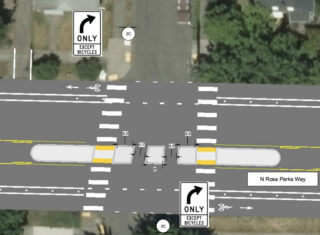
As paving machines and bulldozers rumble and beep along North Rosa Parks Way today as part of a repaving project that started a few weeks ago, the Portland Bureau of Transportation is considering a last-minute change to the project they say provides even more protection for people walking and bicycling.
At issue is the crossing of Rosa Parks at Villard, a street between Willamette Blvd and Greeley Ave. Currently there’s no marked crossing at Villard. That leaves just over 1,100 feet of this neighborhood collector street without a clear and safe place to cross.
Back in March we shared PBOT’s initial design proposal which included two zebra-striped crosswalks and median islands in the middle of the street. As a partial median, the design would do nothing to limit driving movements. Now PBOT says they have the “opportunity” to upgrade this design further by making it a full median diverter that would prohibit some turns for auto users while still allowing bicycle riders to get through.
Here’s the existing view:
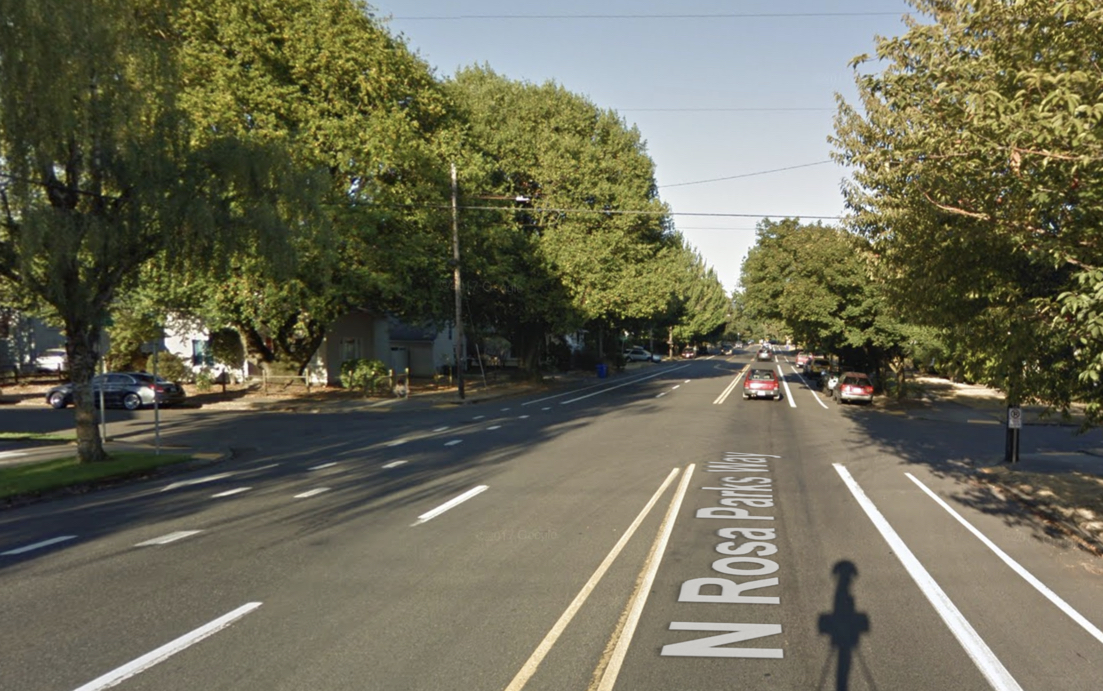
The initial design:
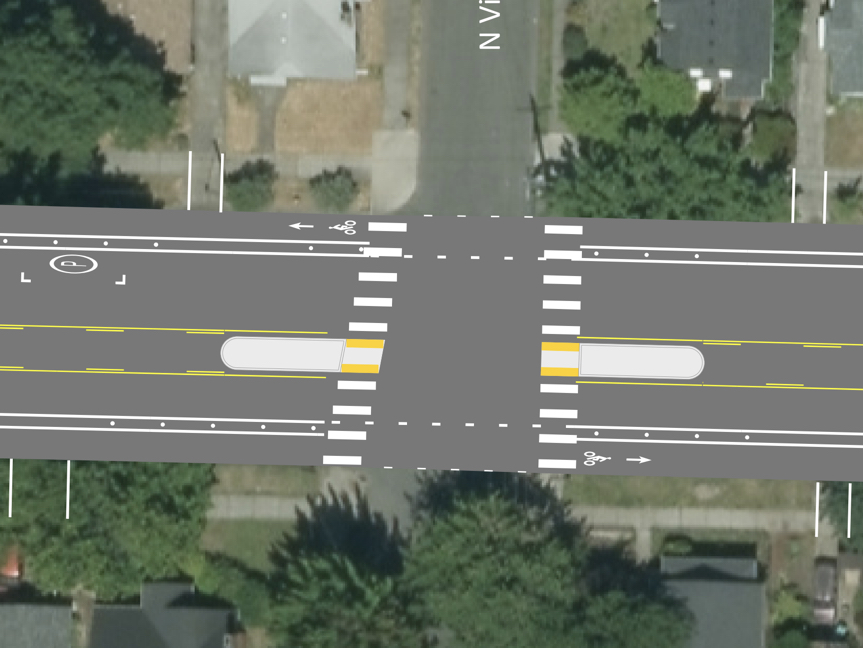
Advertisement
And once again, only larger now, the new proposal:
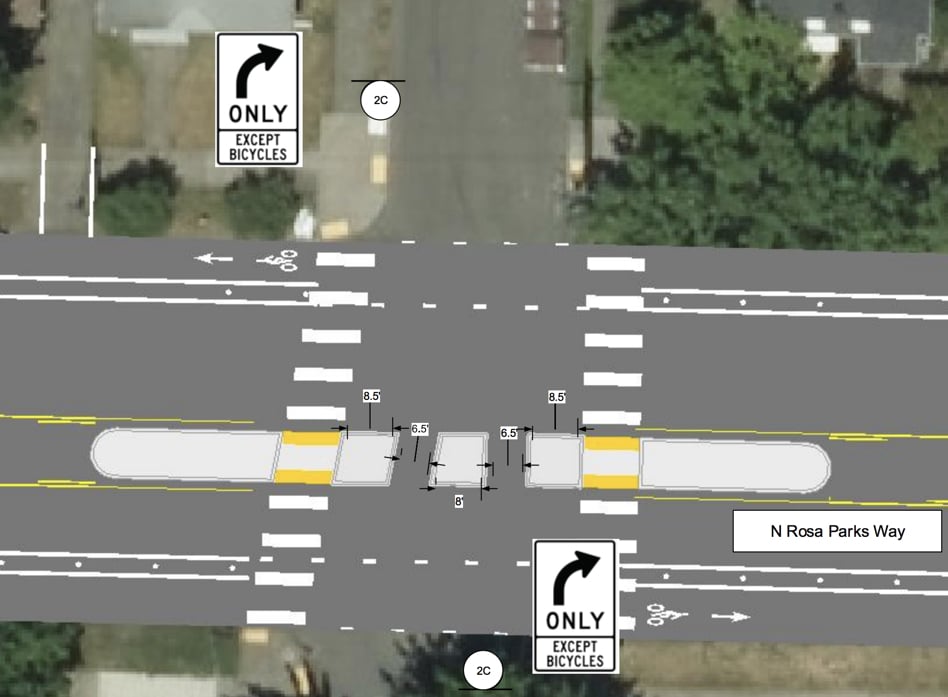
Earlier this week PBOT Project Manager Scott Cohen sent out an email with this proposal. We’re not sure what spurred it (I assume it was a request from the neighborhood); but here’s what Cohen wrote:
“The preferred design includes a full concrete median island in the center turn lane. The design provide increased protection for people walking and bicycling across N Rosa Parks and N Villard. The design provides more space for people walking and bicycling to wait for traffic to clear the lane to proceed across the street. A full median island will require auto traffic to only turn right both in and out of N Villard at the intersection of N Rosa Parks.
The initial design includes smaller refuge areas for people walking across N Rosa Parks. There is no designated space for people bicycling across N Villard to wait for traffic to clear a lane on Rosa Parks before crossing. The design allows full turning movements for all modes of traffic at the intersection of N Villard and N Rosa Parks, but provides less protection for people walking and bicycling.”
PBOT is urging everyone to contact Cohen with feedback and comments about the new design. He can be reached via email at scott.cohen@portlandoregon.gov or by phone at (503) 823-5345.
The new design provides more protection for people walking and bicycling across N Rosa Parks at N Villard. With this design, automobile traffic can only turn right into and out of N Villard. Please contact the project manager to provide comments about the new proposed design.
— Jonathan Maus: (503) 706-8804, @jonathan_maus on Twitter and jonathan@bikeportland.org
Never miss a story. Sign-up for the daily BP Headlines email.
BikePortland needs your support.


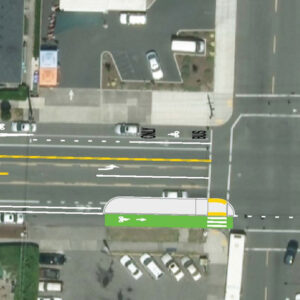
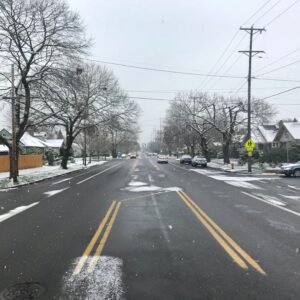
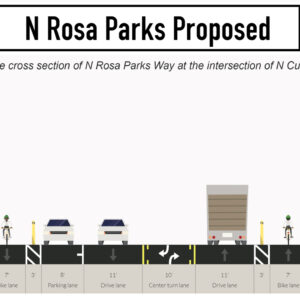

Thanks for reading.
BikePortland has served this community with independent community journalism since 2005. We rely on subscriptions from readers like you to survive. Your financial support is vital in keeping this valuable resource alive and well.
Please subscribe today to strengthen and expand our work.
It’s great to see PBOT going this direction.
But ideally we’d have a diverter that would prevent people from turning right (southbound) from Rosa Parks onto Villard. That’s the big cut-through movement that is ruining the neighborhood as people try to avoid congestion on Greeley and Interstate/I-5 during the PM peak. I’ll be curious to hear what people who live on these streets think.
I hazard to guess that the people of Arbor Lodge feel the same as everyone else in non-terminal neighborhoods. So long as there are seconds to save and useless Internet points to score, somebody is going to be racing down your street.
Most urban neighborhood residents have deliberately chosen against the medieval notion of walled cities, but the Waze barbarians have me thinking twice because there’s not enough money to slow them all down.
With decreasing traffic enforcement from the PBB and increasing hoards of Waze barbarians at the gates it seems we will soon end up with citizens militias manning checkpoints at edges of affected neighborhoods keeping out the motorized marauders. No vacuum of power or authority goes unfilled forever.
We have a retired neighbor who routinely stands in the street during afternoon rush hour to keep the speed of cut-through drivers in check. Our neighborhood has a lot of kids and his actions are appreciated by all. I guess we’ve gotten to that point already.
Yes like a Portland version of Curtis Sliwa’s Guardian Angels from 1970’s NYC. But instead of defeating muggers and bandits on the subways, Portland’s Guardians wood be defeating the greater threat of Waze Barbarians and Motoring Scofflaws.
Thanks for the update! I live right near this intersection and contacted Scott with my support for the proposed changes. Also, you are right about the cut through traffic – I’ve heard some neighbors brainstorming about DIY tactics already.
I have no confidence that the improvements along Rosa Parks will make it any safer for pedestrians and cyclists if there is increase in traffic enforcement.
As evidence: the re-striping and road diet on N Willamette don’t appear to have affected the speed at which motorists are driving. I was cycling to work this morning along N Willamette (around 5.40 a.m.) and the speed indicator just near the turn into Rosa Parks showed that the four cars that passed me were all driving in excess of 35 mph, one doing 45 mph – the posted limit is 30 mph.
Unless and until speed cameras are ubiquitous around Portland, these road diets mean nothing.
I have no confidence that the improvements along Rosa Parks will make it any safer for pedestrians and cyclists if there is NO increase in traffic enforcement.
So what’s your solution? Do nothing until every road has a speed camera?
No, we do need to keep improving the streetscape. However, when PBOT has a splashy show and tell about how they’re making great improvements, we need to ask about enforcement of road rules, and if they have before & after data on actual speeds for prior projects.
I love neighborhood greenways, my personal experience is that motorized traffic is significantly lighter on the ones that I use, than on the “regular” streets a block or two parallel (e.g. N Ainsworth sees a lot less motorize traffic than the parallel N Rosa Parks).
1) The problem on Villard is one of right turns from Eastbound RP onto Southbound Villard. This leads to all the cut through in the neighborhood.
2) This concrete work proposed might be a valid improvement, I have no problem with this, perhaps the people that want to cross RP at Villard (and every other intersection along RP) could use some help in terms of a median. But, the city should look to make a high-impact improvement for their limited $$ in this area, instead. The big curve where the main travel lanes of Willamette Blvd turn into Rosa Parks, exactly 2 blocks West of here is a high-use bike/ped area that could use some improvements. The bike lane is pinched on a tight corner. The bike lane should be widened through the turn. The bushes should be trimmed. The ped/cycle conflict (and lack of visibility due to these bushes) on the south side of this intersection in the mingle zone should be dealt with, etc.
This is another missed opportunity, among others in the neighborhood, to integrate trees and vegetation into these pedestrian/bike crossings. Trees and vegetation would improve traffic calming while improving air and water quality and yielding public health benefits. Some of our most street tree deficient public right-of-ways are exactly these arterial corridors which are urban heat island “hot spots” that create a real public health hazards during our extra dry and hot summers. Both the City’s decade-old Watershed Plan and the new Comp Plan call for integrating green infrastructure in to public improvements for environmental and public health. But with a few exceptions these goals- repeatedly articulated by the community- only get applied in showy one-offs, not in systemically in all infrastructure improvements in all neighborhoods.
PBOT will certainly use the excuse that pavement and concrete is cheaper to maintain. Maybe. But the different and perhaps more routine maintenance that green infrastructure requires brings with it real is an benefits to the public, on top of creating green jobs opportunities.
You going to write the check for that maintenance?
And, a source for the ‘trees slow down cars’ concept. There are plenty of streets in Portland with trees to the side and between cars with measurable speeding problems.
I feel that people drive more slowly in the Maplewood neighborhood of SW Portland than many other nearby streets. It has many street trees.
Trees absolutely contribute to traffic calming and safer streets.
Here is an article that summarizes some of the research: http://www.deeproot.com/blog/blog-entries/trees-are-a-tool-for-safer-streets
They are one in a variety of factors so the fact you see streets you consider unsafe that happen to have trees along them is evidence of nothing with regard to the influence of street trees on safety and calming traffic.
I think we all have some responsibility to help maintain street trees that are part of a system of safer, cleaner public right-of-ways in our communities.
Jim
I live on this street and I’m excited that we might get this improvement, because the cut thru is a real concern for those of us who like a slow traffic street. The cut thru people speed, I am familiar enough with the local cars to know who is just passing through. As far as driving goes, I don’t like to turn left onto Rosa P off Villard anyhow – hard to find an opening when vehicular traffic is heavy- and I doubt I’m in the minority.
I live on this street at Villard and Holman. I am very much in favor of putting in the full island crosswalk as are most of the neighbors I have talked to. It angers me to see cut through morning traffic trying to pass bikers on our narrow side street. Nothing good can come of that situation for anyone. The bikers are already going plenty fast and there is no reason to try and pass them The kid bikers getting to school just use the sidewalk and don’t risk the street. That seems wrong. A residential side street should be safe for all users, not just a personal playground for cut through cars.